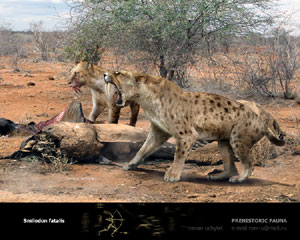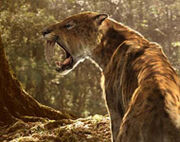m (General fixes) Tag: apiedit |
m (→Anatomy: removing Category:Mammals) Tag: apiedit |
||
| Line 41: | Line 41: | ||
Its still unknown what caused the extinction of this magnificent species. Probably not just because of one reason but because of combination of several, including the appearance of humans (and other animals) in the New World, the new diseases they could have brought with them, and the climate change that caused the megafauna to die out. |
Its still unknown what caused the extinction of this magnificent species. Probably not just because of one reason but because of combination of several, including the appearance of humans (and other animals) in the New World, the new diseases they could have brought with them, and the climate change that caused the megafauna to die out. |
||
| − | [[Category:Mammals]] |
||
[[Category:Carnivores]] |
[[Category:Carnivores]] |
||
[[Category:Primeval]] |
[[Category:Primeval]] |
||
Revision as of 16:37, 10 May 2015
Template:Infobox MammalFirst things first, although Smilodon is referred to as a sabre-tooth tiger by most people, this prehistoric mammal wasn't a true tiger at all, belonging instead to a long extinct group of cats known as the Machairodonts (a related genus unsurprisingly was Machairodus). Other than that, though, what you have heard of is mostly true: Smilodon was a large muscular predator that may have well snacked on early humans as well as the Woolly Mammoths and Giant Ground Sloths from the Pliocene and Pleistocene epochs

Smilodon fatalis
Description
As formidable as it was—and despite what you've seen in popular media—Smilodon didn't hunt like a modern jaguar or puma. Like other sabre-toothed cats (and dirk-toothed cats and scimitar-toothed cats as well), Smilodon would leap on its prey suddenly out of the pampas grass, digging its huge canines into the unfortunate animal's neck and then withdrawing to a safe distance while its dinner bled to death. It's unknown whether Smilodon hunted in packs, though that would have certainly taked down massive herbivores such as Macrauchenia, Toxodon, the giant deer Megaloceros, and the giant prehistoric bovine Auroch.
In case you're wondering why Smilodon has appeared in so many movies, that may be because thousands of intact Smilodon skeletons have been extracted from the Rancho La Brea Tar Pits in Los Angeles, a stone's throw from Hollywood (the California variant of this genus, Smilodon californicus, is the official state fossil). By the way, the last specimen of Smilodon went extinct only 10,000 years ago; by then, primitive humans had figured out how to hunt coorperatively and killed off this poor dangerous menace once and for all. It also didn't hurt that these humans also hunted to extiction the giant, herbivorous megafauna that Smilodon snacked on.
S.gracilis is the smallest species at about a metre long and ancestral to Megantereon. S.populator, the largest species, was 3 metres long and originated from South America, and the third species S.fatalis was intermediate in size between the two species and was from North and South America.

Anatomy
Smilodon was the largest sabre-tooth cat (popularly known as the sabre tooth tiger). He/she was a fierce predator about 7–8 feet (2.1336-2.4384 metres) long and 3.444882 feet (1.05 metres) tall. Smilodon weighed about 396.832072-674.614522 lb (180–306 kg). Smilodon was a bit bigger than a modern-day lion (Panthera Leo), but much heavier. Smilodon had relatively short legs and a short, bobbed tail a bit like that of a modern-day Bobcat. Smilodon's front legs were especially powerful and its body was adapted for springing onto prey, but it was not a very fast runner and could not be adapted for chasing after fast running prey like deer. It could hunt some slower animals such as Macrauchenia, Toxodon, some subspecies of Mammoths, and Ground Sloths.
Its 12 in/1 ft (30.48 cm) skull had 2 huge sabre-like canine teeth and these were serrated,and oval in cross-section. Many Smilodon fossils have been found with broken canines; a fossil wolf was found with a Smilodon tooth fragment embedded in its skull. Smilodon had powerful jaws that opened to 120 degrees while onthe other hand, todays lions can only open their jaws at 65 degrees.

Smildon as it appeared in Walking with Beasts
Smilodon also had strong jaw and neck muscles that let it stab prey with its deadly maxillary canine sabre teeth. Its front incisor teeth may also have been used to wrip away strips of flesh from the bones of its prey. But compared the other big cats this species jaw force is weaker.
Its unknown if the Smilodon could do hunt after lost its teeth but several paleontologists and biologists suggest ıt could be fatal for the big cat.
PALEOBİOLOGY
Its very unclear how this feline lived; several paleontologists suggested the smilodon was a very territorial animal because of high competition on food and territory; lived solitary much like leopards and jaguars like our time from same reasons. The proof of this could be there are no smilodon group/pride fossils ever founded.
But other paleontologists suggest its reverse because of the same reasons; high competition and several other hostile species like Arctodus, dire wolves and the American lion made Smilodon live in pride-like social units. Because of the lions are the only species of felines who do live in loose semi-social groups; this seems very unlikely. But there is 'accepted' proof for this behavior too: several Smilodon skeletons found in the famous La Brea tar pits
RANGE
Smilodon evolved and most commonly lived in North America. When in Pliocene North and South America finaly came together and formed a land bridge, Smilodon were a part of the Great Faunal Interchange: they came to South America and became one of the apex predators there, driving the terror birds to extinction
EXTİNCTİON
Its still unknown what caused the extinction of this magnificent species. Probably not just because of one reason but because of combination of several, including the appearance of humans (and other animals) in the New World, the new diseases they could have brought with them, and the climate change that caused the megafauna to die out.